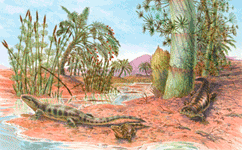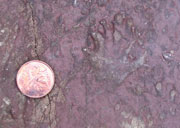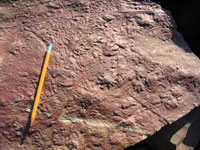Newly-discovered 318-million year old animal tracks in Canada have confirmed the long-held theory that reptiles were the first vertebrates to thrive in Earth's arid inland environments.

© Planet Earth OnlineAncient gecko-like reptiles thrived in continential interiors.
The tracks provide evidence for a key point in the history of life. They were formed during the period that saw the emergence of the first animals to lay hard-shelled eggs - a key feature of the reptiles' success.
A team of UK and Canadian researchers found the footprints in sea cliffs on the Bay of Fundy, New Brunswick, Canada - by a mixture of luck and accident.
'We were looking for plant fossils in a remote location scattered with sandstone boulders,' says Dr Howard Falcon-Lang from Royal Holloway, University of London, who led the research team. 'I tripped over one of the boulders and saw all these wonderful trackways over the surface.'
There are three types of prints. Two rare sets are probably from primitive amphibians. But the vast majority - 179 in all - were identified as belonging to a five-toed, gecko-like reptile around 20cm long.

© Planet Earth OnlineTetrapod footprint close-up.
When the tracks were made Fundy was at the heart of Pangaea, the largest ever continent on Earth. Inland Pangaea was like central Australia is today - very dry and punctuated by water holes and seasonal rivers.
So the reptiles had travelled a long way from the safe watery environment of their amphibian ancestors.
Amphibians' soft eggs have to be laid in water so these creatures don't fare well when water is scarce. But the reptiles' hard-shelled eggs were better adapted to the arid inland conditions.
'This is the earliest evidence of vertebrates that made it into the dry continental interiors,' says Falcon-Lang. 'These creatures were the pioneers of the animal world, the first to really get the hang of surviving in such arid environments.'
Tracks can reveal a lot of information about animals' anatomy and lifestyle but until now they have been somewhat overlooked in favour of bone remains.

© Planet Earth OnlineThe 318-million-year-old fossil trackways.
But, as Falcon-Lang points out, 'Animals leave only one skeleton behind but many thousands of trackways. We can build a picture from their tracks of what they were doing, scampering around the muddy edges of a contracting water hole.'
These particular tracks were preserved when the animals were caught in a downpour and floodwaters covered the prints with sediment. Alongside the prints are distinct marks made by heavy rain, together with 'tool marks' from wood and stones being dragged across the ground by the flood.
It's an evocative picture. 'Even though this all happened 318 million years ago we can still recreate events that lasted only a few moments,' Falcon-Lang concludes.
The team's analysis of the prints is published in
Palaeogeography, Palaeoclimatology, Palaeoecology.



Reader Comments
to our Newsletter